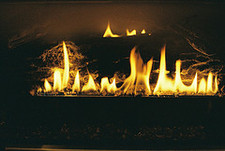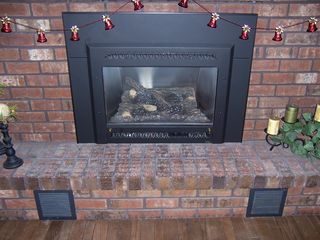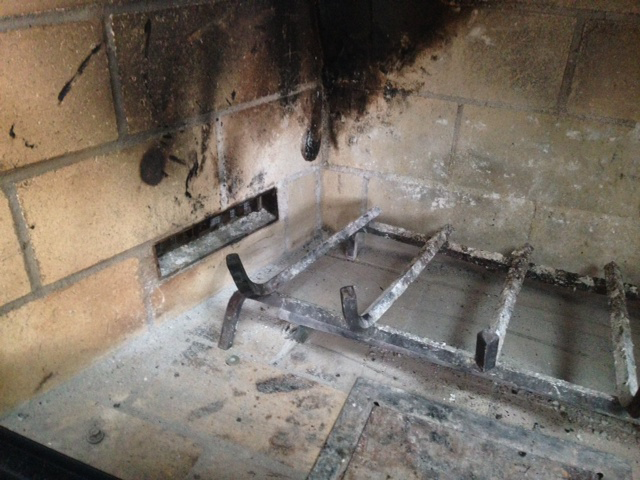by blogediter | Feb 8, 2019 | Chimney Plugs
Q: I accidentally ignited my gas fireplace under my Chimney Balloon (someone had removed the red reminder card from the gas spigot). It fell out of the chimney within 10 seconds. Can I patch the burn hole in my Chimney Balloon? At what temperature does the Chimney Balloon melt and burst? – JG
A: JG, Well your Chimney Balloon did exactly what it is supposed to do when a fire is lit under it, but unfortunately it is not repairable when melted. The hole is going to be just too big.
The answer to your second question is 180 – 220 degrees Fahrenheit it the average melting point of the Chimney Balloon if it is exposed to flame. Your gas fireplace came up to that temperature very rapidly, as gas fireplaces tend to do. Wood fireplaces tend to get to temperature a little slower, but it doesn’t take long for the Chimney Balloon to sacrifice its life for yours. – Jason

by blogediter | Nov 21, 2018 | Gas Logs
Gas Burn
We have often fielded the questions about Gas log fireplaces and why a damper has to be removed or restricted when a gas log fireplace is installed. If a gas log fireplace was installed after 1991 the building codes state that the damper must be disabled or removed. Below is a portion of a Q and A session on www.doityourself.com about this very topic. You can see our Q & A writeups on this topic here. http://www.chimneyballoonusa.com/blog/vented_gas_logs/index.html
Here is the Q & A session from DoIt Yourself.com on gas logs and dampers:
Q: The folks who are buying my home, upon advice of their home inspector, have asked that I remove the fireplace damper prior to closing escrow. I’ve explained that this would be impractical since an open chimney would allow warm air to escape from the home during the winter months. They agreed with this point but insisted that dampers are unsafe when fireplaces have gas burners. This is a new one on me. Are the buyers right about removing the damper? -B
A: Dear Bl, Changes in the safety requirements for fireplace dampers were enacted in 1991, but current standards apply only to newly installed gas log fireplaces…. click here to read the rest of the article”

by blogediter | Sep 21, 2018 | Gas Logs
Gas Burn
Q: Jason, I have a wood fireplace right now but no supply of wood. I am thinking of converting to a gas log fireplace to supplement my home heat. What do you think? -CM
A: CM, I have my opinions on this but this story from a customer speaks so well on the subject I will share that with you instead:
“…If you live in a cold climate area I wouldn’t really recommend you do anything with a wood burning fireplace, but plug up the chimney and maybe put a few candles in it. Why?… because I learned the hard way that fireplaces and gas logs are excellent ways to suck money right out of your pocket.
A few years ago I thought I would supplement my heat by burning wood in my fireplace. Turns out my heating bill went up because the fireplace was sucking the air out of my house when I burned. So I converted to a gas log fireplace (which it sounds to me like you have a partial gas log setup right now that needs fixing.) Well, part of having a gas log installed to code is to disable the damper or clip it open. This was even worse! I was constantly losing heat and the living room was drafty.
I ended up plugging the chimney with a Chimney Balloon to stop the cold draft from coming down the fireplace flue. This was allowable under code since the Chimney Balloon would melt and fall out if I accidentally light a fire under it. You see, this stupid “disable the damper building code” is only there so people don’t light a gas log and leave the damper closed on accident and therefore asphyxiate everyone in the house or set the place ablaze.
OK, long story short…I ran up my heat bill and spent $500 on a professionally installed gas log only to end up with a fireplace I don’t use because it wasted too much heat. So I put candles in it and plugged it with a Chimney Balloon.” – Terry B

by blogediter | Feb 12, 2018 | Chimney Plugs
My Majestic brand direct vent fireplace is letting in cold air
Q: Jason, I have a vented Majestic fireplace. We do not use it, but it is getting tons of cold air into my house. The vent on the outside of the house doesn’t seem to have any sort of damper on it whatsoever… so closing that is not an option. Right now we have the gas turned off & a blanket over it.
Would a Chimney Balloon help with this? How exactly would we get in to measure the hole? How do we get into the part that has the gas logs?– CG
A: Dear CG, With a few hints in your question, I am assuming that you have a direct vent fireplace, not a gas log fireplace. You say “vent to the outside”, does that mean the vent is a PVC pipe that goes directly through the exterior wall, not out the roof like a chimney?
If it vents through the wall you definitely have a direct vent fireplace.
The good news is, that direct vent gas fireplaces (unlike vented gas logs) generate heat efficiently when running. The bad news is, if the fireplace installer does not take care to insulate the fireplace install correctly it will let in a great deal of cold air when dormant.
If you have not had the original installer over to look at the problem I would try that first. If they stonewall you about it, call an insulation contractor that is forward thinking enough to work with closed cell foam.
You see, a fireplace installer will sometimes slap in a fireplace and think “good enough” but an insulation contractor has a different way of thinking. He will look over an install and consider how it affects the home’s envelope and how he can make an install both safe and tight.
I’m sorry but a Chimney Balloon will not help you on a direct vent fireplace since a firebox is a sealed unit and you can’t gain access to the vent flue and that vent flue is just a small pipe through the wall anyway. – Jason

by blogediter | Feb 7, 2018 | Gas Logs
Fresh Air Vent
Q: I have a fairly new home built in 2004. I’ve noticed that my living room area is colder than the rest of the house. I always thought it was because of the patio door or maybe the vaulted ceilings and it’s a large room. There is a fireplace I never use. I just noticed today there is a draft coming through the bottom where the controls are and the tile around the bottom is ice cold. This explains why my toes are so cold when I sit on the couch and watch tv. Is there anything I can do about this? I might just put some kind of insulation sheet in front of the whole thing. thanks for your help – JP
A: JP, There is a couple of different sources that could be letting in cold air. If this is a direct vent fireplace that is mostly sealed off from access and “breaths” through tubes or pipes that go through your outside wall, then it is likely bad or no insulation around the gas lines or venting pipes. This can be remedied easily once you find the pipes. If this fireplace has a regular stack chimney and the hearth is accessible to you, it could be that the fireplace damper is clipped open or disabled in some way. Gas log fireplaces in most states have to have disabled or clipped open dampers due to fire code. The reason for this is the county doesn’t want you lighting a gas fireplace without opening the damper since this can start a fire or asphyxiate you and everyone in the home. Another possibility, in this case, could just be a worn out damper. There is a blog entry about this: http://www.chimneyballoonusa.com/blog/2007/01/welcome_to_the_.html If you find that the cold air source is coming from a disabled, or old and crusty damper and inexpensive insulation option is a Chimney Balloon. They can be bought through the manufacturer at http://www.chimneyballoon.us. They are an inflatable plug that stops air passage. Good luck finding the cold air entry point, I know from experience that cold drafts like that can be uncomfortable. – Jason


